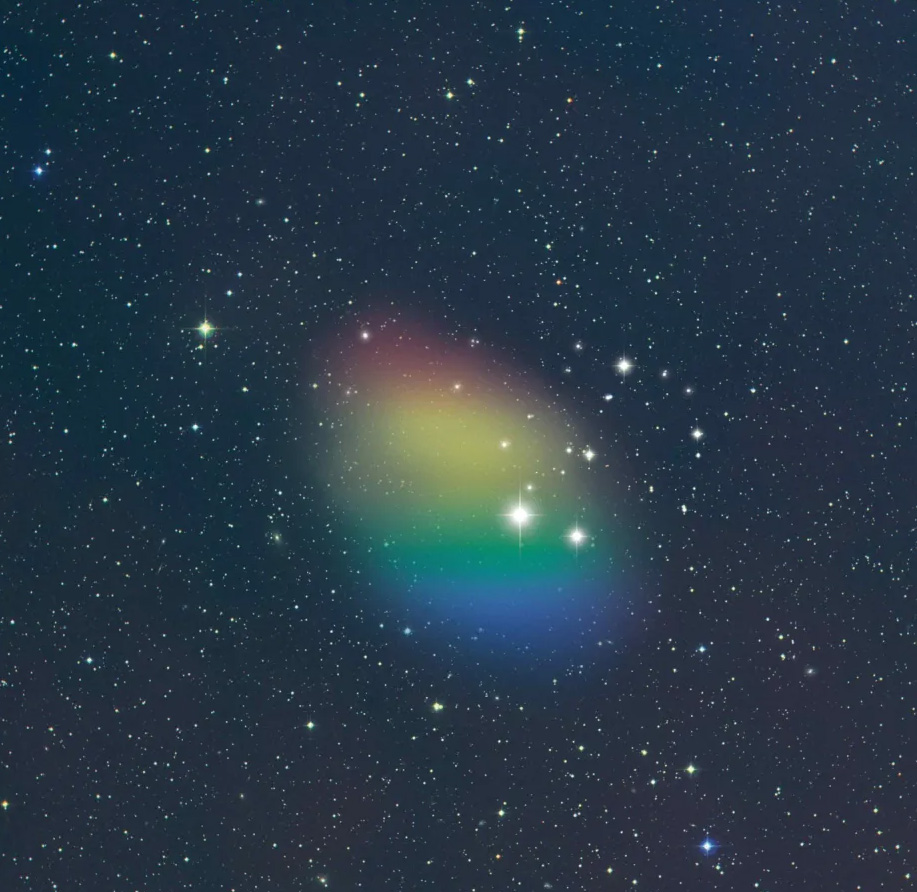There’s a galaxy out there without apparent stars but largely chock full of dark matter. What’s that you say? A galaxy without stars? Isn’t that an impossibility? Not necessarily, according to the astronomers who found it and are trying to explain why it appears starless. “What we do know is that it’s an incredibly gas-rich galaxy,” said Green Bank Observatory’s Karen O’Neil, an astronomer studying this primordial galactic object.
“It’s not demonstrating star formation like we’d expect, probably because its gas is too diffuse. ” O’Neil and a team of colleagues found this odd, seemingly starless object called J0613+52, while they were doing a sky survey. Their target was a set of so-called “Low Surface Brightness” galaxies (LSBG) They used the Green Bank Telescope, the Arecibo Telescope (before its untimely end), and the Nançay Radio Telescope to look at 350 of these dim, diffuse objects.
The idea was to survey them and determine their gas content and dynamic masses. J0613+52 wasn’t one of the team’s original targets. Instead, they stumbled across it while trying to figure out why some of the data from Green Bank and Nançay didn’t match, according to O’Neil.
“The GBT was accidentally pointed to the wrong coordinates and found this object,” she explained, noting that this galaxy was new and unknown. There are no galaxies within 112 parsecs, making it a pretty isolated target. Interestingly, based on their observations, the team found that J0613+52 has about the same characteristics of mass and gas content as a normal spiral.
Yet, it has no stars. That poses a mystery they’d like to solve. The type of galaxy represented by J0613+52 is an odd one when you compare it to the more familiar types such as the star-filled spirals and ellipticals.
For one thing, it’s a dwarf galaxy with an irregular shape. Without any obvious stars, it’s quite dim. The most unusual thing about objects like this one is that dark matter appears to dominate their compositions.
If J0613+52 is like others, it could have up to 95 percent dark matter constraining the neutral gaseous hydrogen that we can detect. So, why no stars in J0613+52? O’Neil describes it as an “unevolved” dwarf. That’s because the neutral hydrogen gas component is too diffuse, and too spread out.
LSBG generally have less gravity and that makes it tough to form stars on their own. So, they evolve very gradually. If they do start to convert gas to stars, it takes a long time for that to happen.
Some astronomers suggest that LSBG are late-forming objects in cosmic time. That might explain the presence of this one in relatively “modern” times. In addition, J0613+52 lies too far from any neighboring galaxies to interact with them gravitationally.
That means they can’t trigger star formation through any possible mergers or collisions. “J0613+52 appears to be both undisturbed and underdeveloped,” she said. “This could be our first discovery of a nearby galaxy made up of primordial gas.
” That means its gas content is largely unchanged over time. J0613+52 is fascinating on its own, but it also has something to say about dark matter. We can’t see this unknown “stuff” but we can measure its gravitational effects.
It seems to dominate in regions where these dwarf LSBG form and that gives astronomers insight into how this stuff is distributed in the Universe. Dark matter content may also explain why galaxies like J0613+52 don’t easily interact with others. Dark matter “halos” act like gatekeepers to keep them apart.
That lack of “contact” may kept it from forming giant stars as a result of collisions. Those kinds of stars are among the first to form. They ultimately die in supernova explosions and seed their environments with the heavy elements needed for ongoing star and planet formation.
J0613+52 and others don’t have those heavy elements, which is another clue that stars aren’t forming inside them. It’s not the first time someone has stumbled across a “dark” galaxy like this one. There are certainly other candidates.
Astronomers found what a dark galaxy called VIRGOH1 21 in 2005 in the Virgo Cluster. One consensus is that it’s made largely of dark matter. That describes J0613+52 as well.
VIRGOH1 21 was found using radio telescopes, too, looking for the vibrations of hydrogen gas molecules. Since its discovery, however, some astronomers have suggested that this dark galaxy could be part of a tidal tail of gas and debris generated by a long-ago galactic collision. That uncertainty is why further observations of J0613+52 will be crucial.
In her presentation at AAS, O’Neil pointed out that it will take high-sensitivity instruments to explore J0613+52 and understand its characteristics. There is a new one about to be installed at Green Bank, called ALPACA (Advanced L-Band Phased Array Camera for Astronomy). Once it’s up and running, ALPACA will extend the field of view of the telescope, allowing astronomers to probe further into J0613+52 and other low surface brightness galaxies like it.
Astronomers Accidentally Discover Dark Primordial Galaxy Low Surface Brightness Galaxies Green Bank Observatory: Technology in the Next Decade.
From: universetoday
URL: https://www.universetoday.com/165279/a-primordial-dark-matter-galaxy-found-without-stars/



